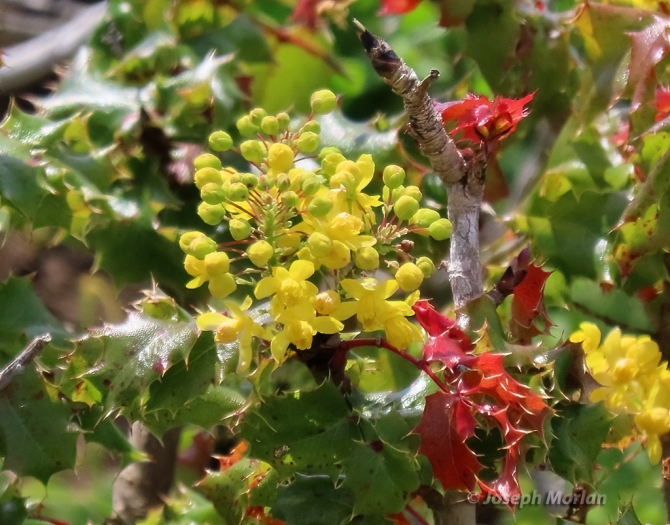California Barberry
(Mahonia pinnata)
California Barberry (Mahonia pinnata)
/
/

© Joseph Morlan
CC BY-SA 4.0
Image By:
© Joseph Morlan
Recorded By:
Copyright:
CC BY-SA 4.0
Copyright Notice:
Photo by: © Joseph Morlan | License Type: CC BY-SA 4.0 | License URL: http://creativecommons.org/licenses/by-sa/4.0/ | Uploader: joseph103 | Publisher: iNaturalist |























Estimated Native Range
Summary
Mahonia pinnata, commonly known as California barberry or wavyleaf barberry, is an evergreen shrub native to the chaparral, mixed evergreen forests, and coastal woodlands of western North America, from British Columbia to Baja California. It typically grows to a height of 2-6 feet (0.6-1.8 meters) with a similar spread. The shrub has a dense, upright form with compound leaves that resemble holly, featuring spiny-toothed, wavy leaflets that are a glossy, dark green. From late winter to early spring, it produces showy, bright yellow flower clusters that attract pollinators, followed by edible, blue-black berries that are a food source for birds and small mammals.
California barberry is valued for its drought tolerance and year-round interest, making it suitable for xeriscaping, native plant gardens, and as a low-maintenance ornamental in residential landscapes. It prefers well-drained soils, tolerates a range of soil types, and requires little supplemental water once established. Full sun to part shade is ideal for this shrub. While generally disease-resistant, it can be susceptible to rust and root rot in poorly drained soils. It is also important to note that the berries and foliage contain alkaloids that may be toxic if ingested in large quantities. The rare subspecies Mahonia pinnata ssp. insularis is federally listed as endangered and is endemic to Santa Cruz Island, California, highlighting the importance of conservation efforts for this species.CC BY-SA 4.0
California barberry is valued for its drought tolerance and year-round interest, making it suitable for xeriscaping, native plant gardens, and as a low-maintenance ornamental in residential landscapes. It prefers well-drained soils, tolerates a range of soil types, and requires little supplemental water once established. Full sun to part shade is ideal for this shrub. While generally disease-resistant, it can be susceptible to rust and root rot in poorly drained soils. It is also important to note that the berries and foliage contain alkaloids that may be toxic if ingested in large quantities. The rare subspecies Mahonia pinnata ssp. insularis is federally listed as endangered and is endemic to Santa Cruz Island, California, highlighting the importance of conservation efforts for this species.CC BY-SA 4.0
Plant Description
- Plant Type: Shrub
- Height: 4-7 feet
- Width: 4-5 feet
- Growth Rate: Slow
- Flower Color: Yellow
- Flowering Season: Spring, Winter
- Leaf Retention: Evergreen
Growth Requirements
- Sun: Full Sun, Part Shade
- Water: Low, Medium
- Drainage: Fast, Slow
Common Uses
Bird Garden, Butterfly Garden, Deer Resistant, Drought Tolerant, Low Maintenance, Showy Flowers
Natural Habitat
Chaparral, mixed evergreen forests, and coastal woodlands
Other Names
Common Names: California Barberry, Creeping Barberry, Creeping Hollygrape
Scientific Names: , Mahonia pinnata,
GBIF Accepted Name: